In a trial in Argentina, the new rods reduced connection failures and raised output.
Herial Angeletti, Miguel Colla and Ricardo Mazzola, Pan American Energy; Daniel Muse, Félix Carrizo and Francisco Diaz Telli, Tenaris Sucker Rods
More demanding operating conditions, such as deeper wells and higher production, are pushing rod pumping artificial lift systems to their limits. This trend was demonstrated at Cerro Dragón Field in southern Argentina (Fig. 1), where the operator had increased utilization of secondary recovery and, with it, the total production flow per well. This increase was pushing the field’s rod pumping systems to their limits. Rod pin and coupling failures had become common problems in the field, demonstrating that the rod connection is the weakest link in a rod pumping system when working at very high loads, Fig. 2. This means that the fatigue resistance of the connection is inferior to the fatigue resistance of the rod body.
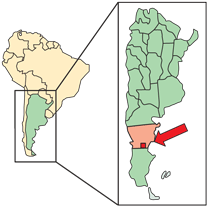 |
|
Fig. 1. Cerro Dragón Field location.
|
|
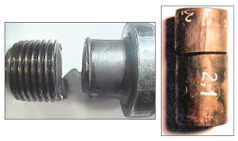 |
|
Fig. 2. Common rod pin and coupling failures.
|
|
As a result, sucker rod connection failures represented one of largest constraints on rod pumping applications in the mature field, which is operated by Pan American Energy (PAE), a joint venture of BP (60%) and Bridas Corp. (40%).
As three-quarters of the more than 2,600 wells in Cerro Dragón are produced using rod pumping systems, several attempts were made to determine a practical solution to this problem. Finally, as part of a larger program of improvements in the development area, a new rod with an innovative connection design was developed by Tenaris. Following finite element analysis and lab tests, the improved connection design was field tested in PAE’s Cerro Dragón wells. More than 10 months of field experience of the new rods working under very high loads in deep wells (producing on average more than 550 bpd at 7,200-ft depth) has demonstrated the new design’s effectiveness in handling these demanding conditions.
THE CONNECTION
Investigation of the rod pin and coupling failures that had plagued Cerro Dragón Field uncovered a number of thread design limitations in the conventional rods being used there, Fig. 3. One of these limitations is a loosening tendency of the connection due to a gap between threads. This gap allows movement between coupling and pin threads when rods suffer from compression and/or shocks. Thus, rising production volume is accompanied by increasing movement between the pin and the coupling.
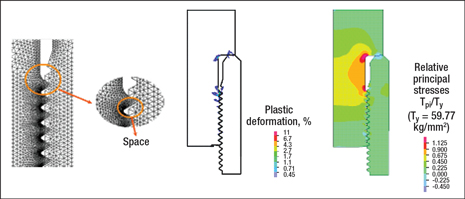 |
|
Fig. 3. Conventional thread limitations.
|
|
Also, finite-element analysis verified permanent deformations in the thread during well and make-up operations. These deformations facilitate the appearance and propagation of cracks. They also result in difficult make-up operations when repeating displacements. Finite-element analysis also revealed a non-uniform stress distribution in the thread profile. This generates regions of high stress concentration and, as a result, makes the pin and coupling more susceptible to crack appearance. It was observed that the conventional rod connections were easily over-torqued during make-up operations, which could account for the permanent deformations in the thread.
The main characteristics of the new connection design are:
• A tapered trapezium profile thread
• Diametrical interference of the pin and the coupling, with flank-to-flank contact
• Low make-up pin stress.
With these characteristics, the gap between the pin and the coupling in conventional threads was eliminated. Consequently, the loosening tendency was reduced, permanent deformations in the threads were reduced, and an improvement in stress distribution was achieved for both the make-up operation and operational fatigue. In general, a significant stress reduction at the pin/coupling shoulder interface was achieved, Fig. 4.
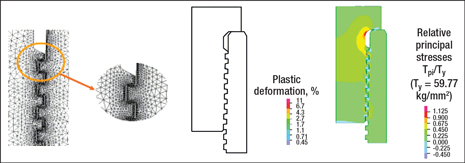 |
|
Fig. 4. New connection design benefits.
|
|
FIELD EXPERIENCE
At the time of the field trial, Cerro Dragón Field had 2,644 production wells with average output of 100,000 bopd and 950,000 bpd of total liquids. Of these production wells, 56% were produced using secondary recovery methods, including 800,000 bpd of water injection in 450 injection wells. Rod pumping was used in 75% of the production wells.
For the field trial, the rods with the new connection design were installed in 10 wells. The trial had two objectives, each addressed by a different group of test wells: reducing failure rate and increasing production.
Reduce connection failure rate. Rods with the new connection design were installed in four wells that had previously been produced with conventional sucker rods. These four wells had an average pump depth and production rate of 6,460 ft (1,970 m) and 634 bpd, respectively. Their connection failure rate had previously been between two and five failures per year, Table 1. Case Well 02 has almost doubled its standard running life, while well Case Well 06 has almost tripled its running life.
| TABLE 1. Failure-rate-reduction well characteristics |
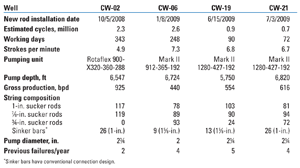 |
High loads/production increase. In the other well group, consisting of six wells, rod pumping using conventional sucker rods was almost not feasible because of the high loads; in fact, electrical submersible pumps were being used instead of rod pumping systems in three of those wells, Table 2. The average depth and production rate for these wells are 7,863 ft (2,397 m) and 453 bpd, respectively.
| TABLE 2. High-load well characteristics |
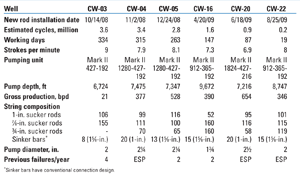 |
Case Well 16, the deepest well tested, faced casing integrity problems as well as a high sand cut. As a result, this well could not be produced at the high flowrate required until the new sucker rods were installed. A regular Grade D rod string would be working at close to 200% of its rated stress under these well conditions, as determined by use of the API-recommended modified Goodman stress diagram. To decrease this stress, the new sucker rod string installed in CW-16 was very lightweight, with only 13.4% consisted of 1-in. rods, the rest being mainly ⅞-in. and ¾-in. rods.
Replacing electrical submersible pumps with rod pumping systems allowed the operator to achieve greater efficiency due to lower energy costs, to use equipment that was already in stock (i.e., pump jacks) and to conduct less maintenance work.
MAKE-UP EXPERIENCE
Two main benefits of the new rod design were seen during make-up. The connection displayed excellent repetition in circumferential displacement; i.e., for a given amount of torque, different rods rotated the same amount when connecting. Furthermore, the torque-resistant threads and shoulders made it almost impossible to over-torque the connections.
Only two differences were encountered in running the new rods vs. conventional rod strings. First, on the new rods, the power-tong calibration has to be done in two steps: The first step ensures coupling-pin contact, and the second step torques the connecting rod to the required circumferential displacement. The use of power tongs is important since making up the new rods requires pressures close to 10% higher than are required for make-up of conventional rods. The second difference is that pony-rod crossovers must be used to connect a conventional pump or polished rod to the new rod connection.
The rig crew reported that the running operation for the new rods was straightforward and simple, and that the rods displayed excellent behavior during all make-up operations.
RESULTS AND CONCLUSIONS
PAE has addressed high rod connection failure rates in wells with very high loads by replacing conventional rod strings with rods featuring a new connection design. Results from the 10 wells field tested have been positive: PAE has encountered no failures due to the rod string thus far, though strings were lifted and re-run due to pump failures.
PAE is planning to extend its experience to new wells and attempt to pump even greater output with the new rods. The company plans to continue testing lighter rod strings, such as that in CW-16, in order to reduce the horsepower requirements in the pump jack and flow losses inside the tubing string. 
|
THE AUTHOR
|
| |
Herial Angeletti earned a degree in petroleum and perforation engineering from the Universidad Nacional de la Patagonia San Juan Bosco (UNPSJB), Argentina. He also received a project management specialization at the Universidad de Belgrano, Argentina. He has been working with workovers and artificial lift systems for almost 20 years, in positions at Argentina’s Cadipsa and Tecpetrol and France’s Total. Since 2002, he has worked for Pan American Energy (PAE) in the areas of production, automation and technical support.
|
|
| |
Miguel Colla is Head of Production Engineering and Technical Insurance in the Cerro Dragón area for PAE, and has worked with the company since 2001. He earned a production engineering degree from UNPSJB and has 17 years of oil production experience.
|
|
| |
Ricardo Mazzola is a Production Engineering and Secondary Recovery Manager for PAE working in the Cerro Dragón area. He earened a bachelor’s degree in petroleum and gas from the Instituto Universitario de Santa Cruz, Argentina. He has more than 22 years of experience in the oil industry with Bridas and PAE.
|
|
| |
Daniel Muse is the Technical Assistance Manager for Tenaris Sucker Rods. He earned a chemical engineering degree from the Universidad Nacional de San Luis, Argentina. He has been working with Tenaris for 16 years.
|
|
| |
Félix Carrizo is a Mechanical Technician with more than 40 years of experience in the oil industry. He worked for YPF and Baker Hughes before managing new businesses for Geopatagonia. He joined Tenaris in 1988 and has worked since then in the company’s commercial technical department.
|
|
| |
Francisco Diaz Telli earned an industrial engineering degree from the Universidad Nacional de Córdoba, Argentina, and a mechanical specialization from the Ecole Nationale d’Ingénieurs de Saint-Etienne, France. He also received an MBA degree at the Universidad Austral, Argentina. Mr. Diaz Telli joined Tenaris in 2003 and has been engaged in technical assistance for customers since then.
|
|








